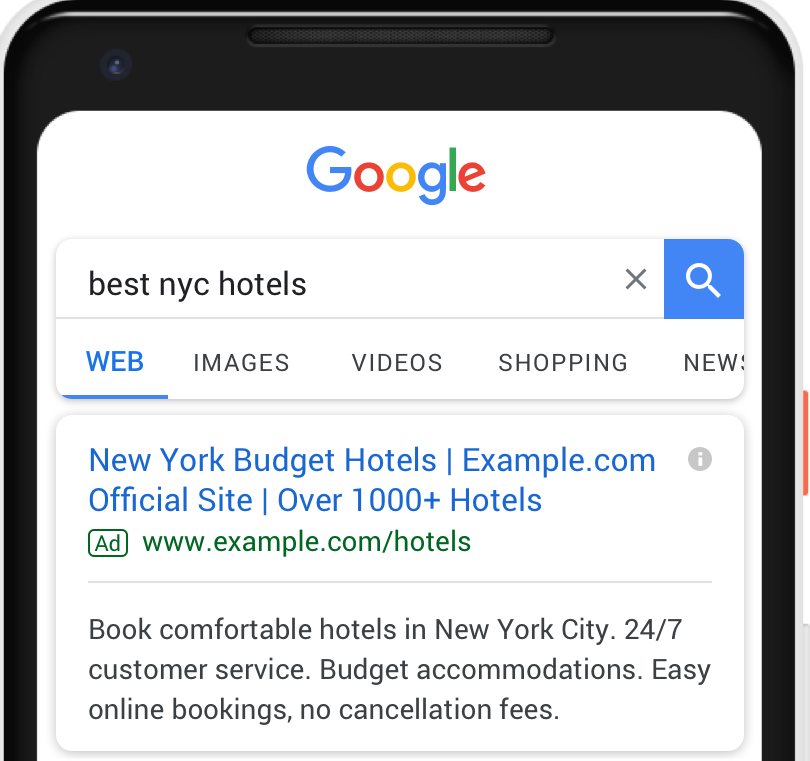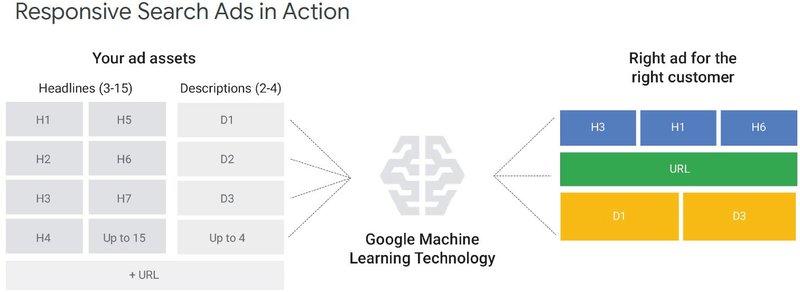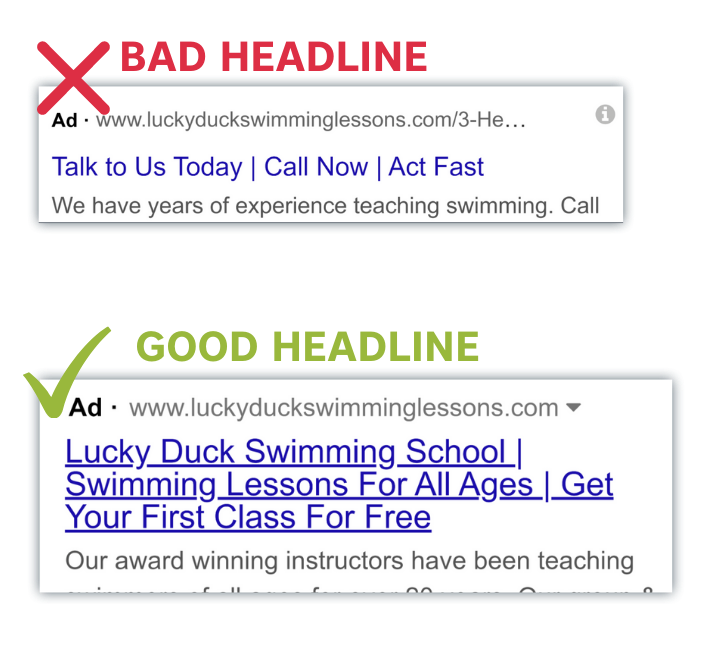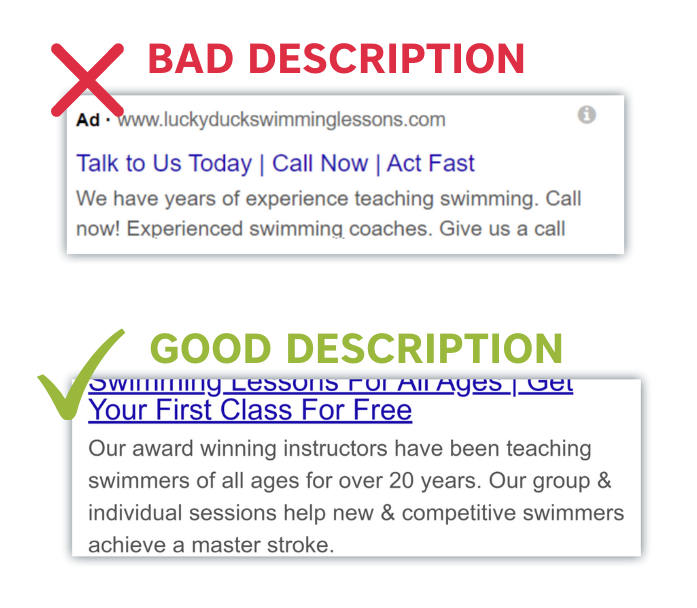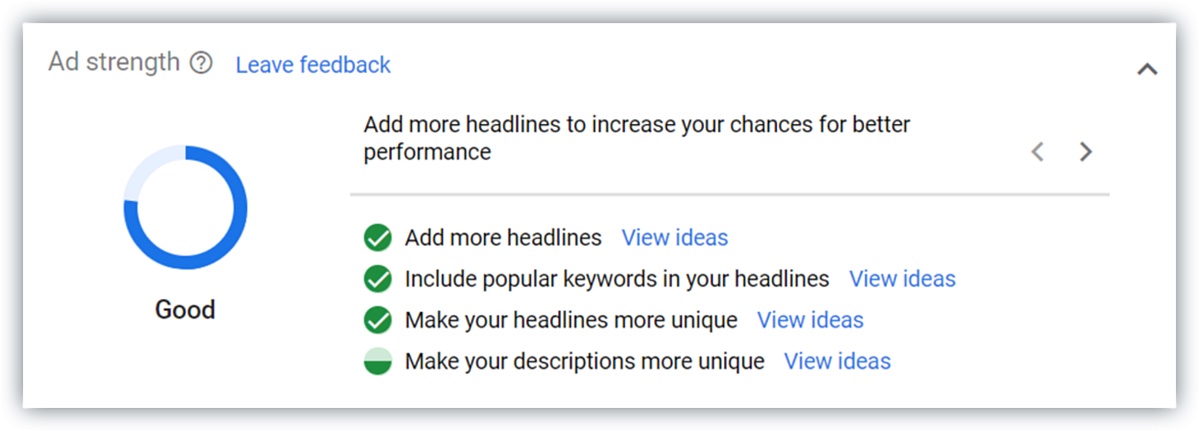If you’ve spent any time managing your small business’ Google Ads account, you’re well aware that as of June 30, 2022, expanded text ads have been sunset entirely. Four years after their introduction and barely over a year after making them the default ad type for text ads, responsive search ads are now the ONLY text ad option on Google.
In this article, we will explain what responsive search ads are, why they’ve become the only text ad option Google offers, as well as how you can build RSAs that help drive qualified traffic that’s more likely to convert into customers for your small business.
What Are Responsive Search Ads (RSAs)?
Responsive search ads are designed to automatically adjust their size, appearance, and even messaging in order to be shown across the Google network in the most effective way possible.
This means that RSAs can show up on Google Search, Google Shopping, and even Gmail. And regardless of where they appear, they’re able to not only display well as an ad, but the ad itself will be tailored to the person it’s targeting.
How Do Responsive Search Ads Work?
Google responsive search ads are made up of three key components:
- Headlines: You can have up to 15 headlines for your responsive search ad. Google will then test different combinations of these headlines in order to determine which ones perform the best.
- Descriptions: You can have up to 4 descriptions for your responsive search ad. Like the headlines, Google will test different combinations of these descriptions in order to determine which ones perform the best.
- Path Fields: Path fields are optional but highly recommended. Path fields allow you to include up to two pieces of additional information about your website or business. This could be something like your website URL or a specific product page.
What are the Benefits of Responsive Search Ads?
When it comes to Google Ads, it all boils down impressions, clicks, and conversions. The higher your Quality Scores with Google, the more effective your ads will be and the better your KPIs will be.
Here are the key questions to ask:
- How many people see your ad?
- What percent end up clicking on it?
- Of those that arrive at your site, what percent end up taking action?
It doesn’t do any good to have more people seeing your ads, if they’re completely uninterested and never end up clicking on them. Likewise, it’s a waste of budget if your ads are well-written but misleading, resulting in a high volume of clicks and traffic but no conversions.
When it comes to RSAs, the reality is that if done well, all of these three KPIs will improve.
More people should see your ads as a result of the customized content, then it’s just up to you to make sure you’re using the best combination of keywords and negative keywords to reach the right people. They’ll not only be more compelled to click on your ad but when they do, they’ll be more likely to convert.
So what’s the secret sauce in responsive search ads?
By giving Google multiple combinations of ads it can serve, its intelligent algorithms and user data can hone in on the most effective message for each individual searcher.
Read that again. “For each individual searcher” – that’s the key part. Google knows a lot about that searcher, including perhaps words they like and use, or even tones they gravitate towards.
If Google understands that a searcher is more likely to respond to humour, and you’ve created ad combinations that can combine powerful messaging with humour, Google knows to serve that type of ad. In turn, that person is more likely to not only see your ad but also to click on it.
Why are RSAs the Only Type of Text Ad Offered by Google?
If Google is forcing advertisers to use a certain type of ad, it means it’s better at attracting clicks that Google can then sell. But why is Google throwing all of their eggs into this one basket?
Google’s machine learning allows for faster optimizations.
As an advertiser, you certainly have some idea of the overarching messaging you want to get across to a potential customer. But Google knows so much more than any of us possibly could about our customers.
Google sees 8.5 billion searches per day! And each time someone searches with Google, its machines learn something, not only about the website they displayed but also the person that performed the search.
Responsive search ads tap into all of the knowledge acquired by Google’s machines and, in theory, create ads that are most likely to succeed – that’s good business for Google. It means you’ll want to do more advertising with them.
RSAs mean easier account management.
While it’s true that the initial build of RSAs takes a bit more time than traditional expanded text ads, once set up, it allows for easier and better management.
For many small businesses using Google Ads for the first time, a marketer might come in and set up a couple of ads, but find it difficult to make time for monitoring, analyzing, and adjusting copy in those ads. When left alone or incomplete, ads won’t do well, and that person isn’t likely to continue with Google Ads.
With RSAs, that high level of account management and optimization isn’t necessarily required. Google’s hope is that this will allow more small businesses to effectively buy clicks from their network without having to spend as much time doing it.
Given how many combinations can be displayed, if set up correctly, Google can essentially take over the account management process and deliver the best combination of ads for any given search that meets your keyword and demographic criteria.
That doesn’t mean it’s always the best idea to let robots control your advertising and treat RSAs as a set-it-and-forget-it campaign. It just means that you can let the automation find winning combinations of copy, and focus your time on monitoring performance and adjusting budget.
They fit within Google’s desire to provide a turnkey ad solution.
If you’ve spent time managing Google Ads for your small business over the years, the one constant theme you’ve undoubtedly noticed is that Google ultimately wants to own as much of the experience as possible.
They don’t want their advertisers to get bogged down in the details. They want your small business to let the ad platform do its thing: drive high intent traffic that has the best chance of turning into a customer, so you tell others to use Google Ads.
How to Create Responsive Search Ads to Drive Qualified Traffic
Now that we’ve explained what RSAs are and why they’re the only type of text ad available on Google, let’s talk about how you can build ads that actually drive qualified traffic to your small business website.
When it comes to building RSAs, there are a few key things to keep in mind.
1. Keep your headlines short and sweet.
You have up to 15 characters for each of your ad’s headlines. That might not seem like a lot, but a stong headline is short, sweet, and concise.
2. Use relevant keywords.
In order for your ads to be shown to people who have the right search intent, make sure that you’re using relevant keywords throughout your headlines, and create meta descriptions that are free from unnatural keyword stuffing.
3. Make ad copy stand alone.
With RSAs, you’re putting together the building blocks and ultimately letting Google complete the construction. To make sure you’re going to end up with a finished product that makes sense, ensure that both your headlines and descriptions make sense on their own, so that if paired together, they’ll play well together.
4. Don’t be redundant.
Given that any combination of headlines and descriptions could end up paired together, make sure you’re not saying the same thing in both places.
In the bad example above, you can see the redundancy produced when the building blocks are put together. Conversely, the description in the good example flows well together, with each building block bringing something appealing and fresh to the ad.
Here’s a helpful resource: 10 tips to write effective Google Ads.
5. Test, test, test.
Google will automatically test different combinations of your headlines and descriptions in order to determine which ones perform the best. But you should still keep an eye on your responsive text ads, and make sure that you’re constantly testing different versions in order to ensure that you’re getting the most bang for your buck.
Continually feeding Google more ad combinations lets it flex its muscles to ensure even better KPIs for your small business Google Ads.
To get a much better understanding of website visitor behaviour and fine tune your ad efforts, get technical with your analysis. Building a Google analytics report will allow you to analyze all of your traffic channels, as well as better understand what visitors do while on your site.
In this way, you can test various approaches to your Google Ads to increase your conversion rates, and see a higher return on your advertising spend.
6. Don’t pin too many headlines/descriptions.
While Google gives you the ability to ensure a certain message stays pinned in its position, overdoing it defeats the point of RSAs by decreasing the likely combinations that can be displayed to hone in on the best.
7. Check your ad score.
Google has a handy tool that scores your ads based on the uniqueness and relevance of the messaging. Continue tinkering until you get high scores, as they will directly correlate to more traffic and more conversions on your site.
RSAs are clearly here to stay. They represent yet another iteration of Google Ads that gives Google itself more control. Whether you are a small business owner or you manage the marketing program for your company, that can be a difficult pill to swallow.
But the reality is this: responsive search ads work. Google has spent the better part of the past four years implementing, analyzing, and improving them.
While the process of building them can sometimes be a bit clumsy, and seeing the ad combinations Google spits out can make you scratch your head, if you arm Google with the right ingredients it can cook up magic.
If you tried Google Ads in the past and didn’t see any success, it may be time to revisit their advertising platform. RSAs could just be the missing ingredient for your business!

